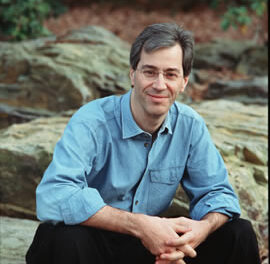Members of the excellent string faculty were on display as the University of North Carolina School of the Arts presented its annual Mozart Birthday Concert. According to cellist Brooks Whitehouse, this annual event is in its “umpteenth” year, maybe the 42nd.
Whitehouse told the large audience that the recital featured three “lesser-known” works all by Wolfgang Amadeus Mozart (1756-91). He also explained several connections all three works had with the Haydn family.
Mozart’s String Duo in G, KV 423 (1783) (along with the B-flat Duo, K. 424), for example, completed a set of six duos, the first four of which were penned by Michael Haydn (1737-1806), the younger brother of Joseph (1732-1809). This three-movement work was performed by Kevin Lawrence, violin, and Ulrich Eichenauer, viola. The opening Allegro immediately revealed the duo’s exquisite intonation and good energy. The score contains both virtuosic passages as well as tender lyricism. The two musicians interacted, on the one hand independently, but always in synch with the other. The slow movement featured some fancy violin filigree over a slower-moving viola. The perky tune of the finale bustled with gusto. Both Lawrence and Eichenauer made subtle changes in repeated passages, casting the music in a different light.
The Piano Trio in G, KV 564 (1788), which probably began life as a solo piano sonata, was up next. Whitehouse explained that compared to J. Haydn’s piano trios (he wrote 45 of them), in which the string parts are secondary to the piano, Mozart distributes the material more evenly between the three. The fact that Mozart added string lines to the piano sonata may help explain the independence of the parts.
Whitehouse was joined by Lawrence and pianist Dmitri Vorobiev for this delightful work, also in three movements. The sparkling Allegro begins with the piano introducing the main tune, reiterated immediately by the strings. The good-natured movement flowed easily from the trio, although sometimes the piano rushed in passages that highlighted the instrument. The Andante, a theme and variations, is also good humored, and all three seemed to enjoy the catchy tune and its cute reiterations. The variation in minor was especially beautifully played. The finale, ostensibly a waltz, is primarily comprised of a “little naïve tune.” But the composer subjects the melody to numerous transformations resulting in clever twists and turns; the gentle conclusion comes as a bit of a surprise. Throughout the work, each musician confidently took the spotlight when the tune was award to him. Excellent communication between the three resulted in tight ensemble, and intonation was spot on.
Whitehouse was joined by Ida Bieler and Janet Orenstein, violins, and Eichenauer and UNCSA senior Julian Smart, violas, for the String Quintet in D, KV 593 (1790). Bieler offered interesting aspects about the work, including that it was commissioned by an unnamed “amateur Hungarian,” although the violinist assured the audience there was nothing amateurish about the music. Eichenauer took a moment to tell the story of Mozart and Haydn alternately playing the first viola part when the work was read through in Vienna.
A series of mysterious, ascending lines from the cello, each solemnly answered by the other four players, opens the work. The genial Allegro follows although there are some chromatic and dark stormy passages as well. Although each of the five musicians are given some important licks, it is clear that the first violin, first viola and cello are the “first among equals.” The slow second movement is a gem, chocked full of profoundly beautiful and poignant passages, lovingly played by the ensemble. The Minuet is loaded with independent lines, clearly brought out. The Trio featured fun pizzicatos. The finale flies, and Bieler negotiated the leading role with finesse and great musicality, and the furious fiddling was finely played by all five. The contrapuntal tour-de-force movement brings the entire work to a brilliant conclusion.
The great acoustics of Watson Hall are perfect for chamber music, providing an ideal space for the brilliant playing of the UNCSA faculty. Mozart’s birthday is really on the 27th, but a marvelous performance is a great way to celebrate a day early.











